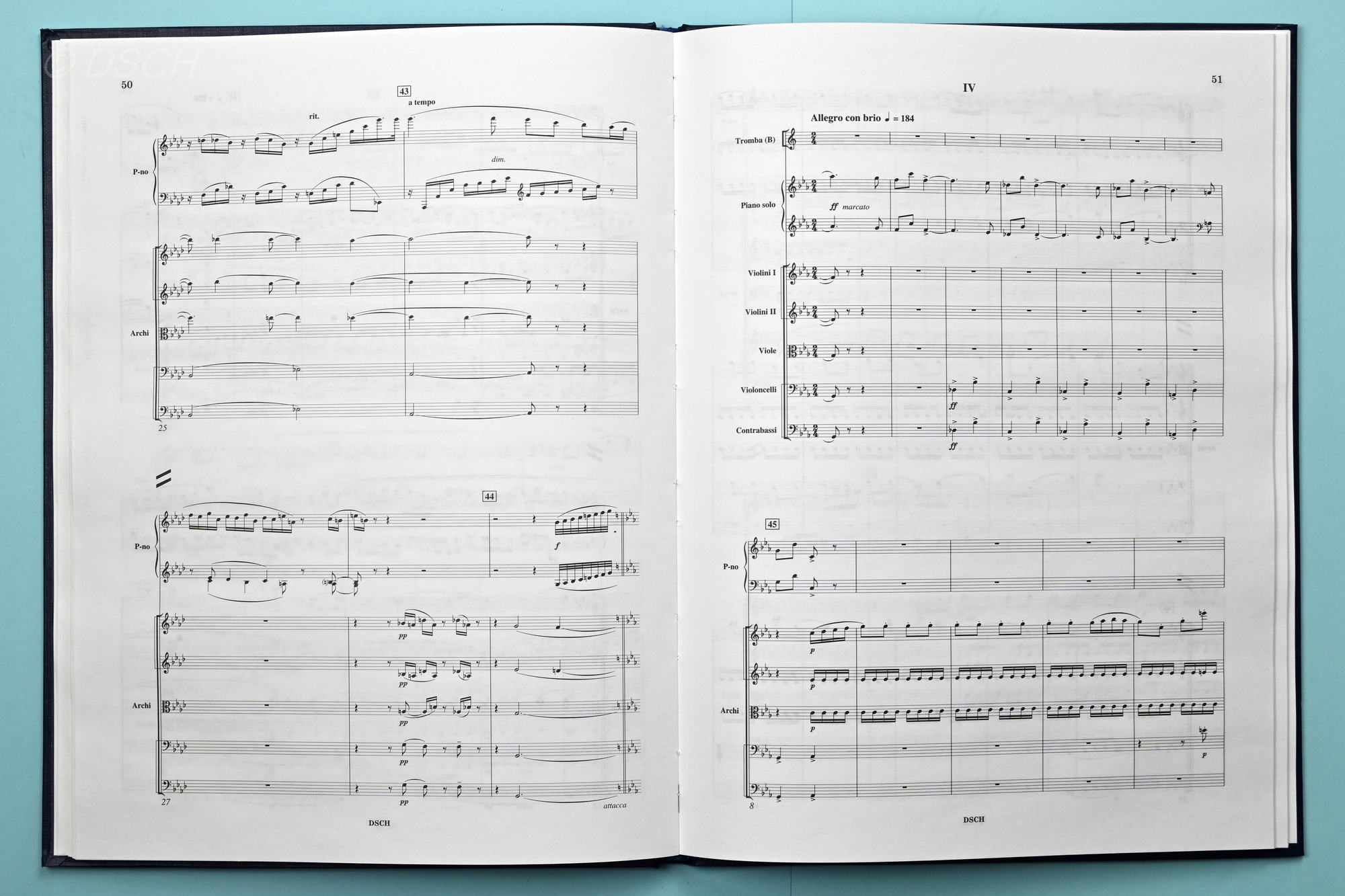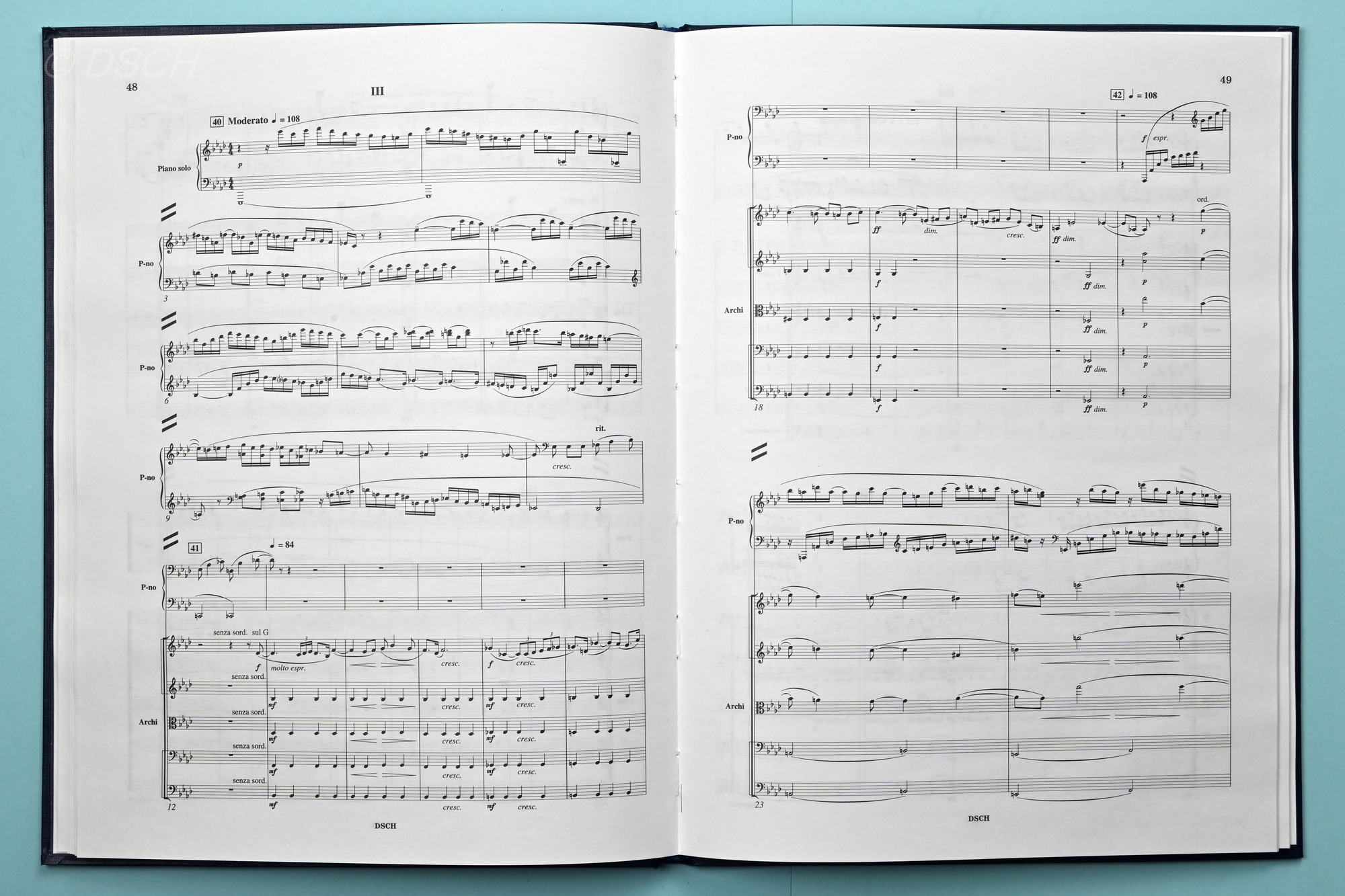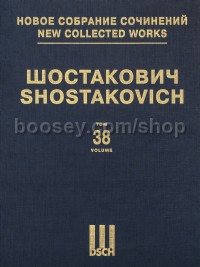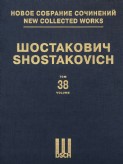Piano Concerto No.1 in C minor Op. 35 Full Score (New Collected Works vol.38)
Series III: Instrumental Concertos
Dmitri Shostakovich
Piano Concerto No.1 in C minor Op. 35 Full Score (New Collected Works vol.38)
Series III: Instrumental Concertos
Dmitri Shostakovich
Vol No: 38
Instrumentation: (full score) New Collected Works 38
Publisher: DSCH Publishers
Catalogue No: M060122279
ISMN: 9790060122279
Shop Product Code: 242482E
$81.27 *
Currently Unavailable - Click the Availability Alert to enter your name and email address. We will notify you when this item is available to order.
* Estimated price converted from UK retail price
Click below to view music sample pages


The score of the First Piano Concerto was published three times in the Soviet Union during Shostakovich’s lifetime: in 1934, 1935, and 1963 (all three editions were published by Muzgiz Publishers; the orchestral parts were printed at the same time as the second edition of the score). The author’s arrangement of the concerto for two pianos was published by Muzgiz in 1934 and 1935 and by Muzyka Publishers in 1969 (in Volume 3 of Dmitri Shostakovich’s Compositions for Piano) and 1975.
The score and piano score of the concerto were also included in Volume 12 (1982) and 13 (1983) of Shostakovich’s Collected Works put out by Muzyka Publishers, respectively. This publication is based on the author’s manuscript of the score kept in the depository of the State Music Publishers (Muzgiz) in RSALA (rec. gr. 653, inv. 1, f. 2266a). When necessary, the text of the author’s manuscript was also collated with the author’s manuscript of the piano score, the lifetime editions of the score, the piano score, and Collected Works. Some clarifications in the 1982 and 1983 publications are also taken into account, particularly those introduced in keeping with the audio recording of the author’s performance of the concerto made in 1957.
There is quite a number of differences not only in the texts of the score and piano score, but also in the different editions of the score (as well as in different editions of the piano score). For example, in the first lifetime editions of the score (1934 and 1935) there are no accents either in the solo Piano, or in the orchestra in bars 449-452 on the second beats of the bars. In the editions of the author’s arrangement of the concerto for two pianos that came out at the same time, the accents have been inserted on all the second beats of the bars only in the Piano I part. In the 1982 edition of the score (Collected Works, Vol. 12), accents have also been inserted in the solo part.
In the piano score published by the same publishers at almost the same time as the score (Collected Works, Vol. 13, 1983), the accents on the second beats of the bars have also been inserted in the Piano I part and in the Piano II part. It stands to reason that such differences have created significant notation difficulties when trying to establish the optimal edition of the score and piano score in this publication. The most complicated instances are stipulated in these comments.
There are also significant differences intentionally introduced by the author in the solo piano parts in the score and in the author’s arrangement of the concerto. The thing is that in the arrangement of the concerto for two pianos, Shostakovich introduced music into the part of the solo instrument in several places that supplements the second piano part in order to more fully reflect the score. The composer placed all of these insertions in square brackets and furnished the following oft repeated note: “The group of notes in brackets should be played only when performing the concerto in two pianos.” Shostakovich made a total of thirty such insertions of different sizes, from one chord (the bar before number 42) or several notes to large fragments (31 bars from number 68 to number 71). It goes without saying that these differences do not require comments and are not reflected here.
In the bar-by-bar comments, the notes from Volumes 12 and 13 of Collected Works and the information provided by Viktor Ekimovsky, the music editor of this volume, are taken into account.
Orchestra:
Trumpet (B), Piano solo, Strings
This ambitious series by DSCH, the exclusive publisher of the works of Dmitri Shostakovich, when complete, will run to 150 volumes.
Based on authentic manuscripts, accompanied by commentaries in Russian and in English, each volume contains new engravings, articles relating to the history of the compositions, facsimile pages of Shostakovich's manuscripts, outlines, and rough drafts.
Divided into 15 different "series" or genres, the edition will include nearly all the original works of the composer, and his instrumentation of music by Domenico Scarlatti, Beethoven, Schubert, Schumann, Mussorgsky, Rimsky-Korsakov, Johann Strauss, Youmans, Braga, Tishchenko, and others.
25% of the New Collected Works will be made up of previously unpublished material: over 80 of his works are being published here for the first time. Many of these previously unknown works could not be published or performed during the composer's lifetime for ideological reasons.
The fifteen "series" within the edition comprise:
I: Symphonies (vols 1-30)
II: Orchestra Compositions (vols 31-37)
III: Instrumental Concertos (vols 38-49)
IV: Compositions for the Stage (vols 50-67)
V: Suites from Operas and Ballets (vols 68-72)
VI: Compositions for Choir and Orchestra (With or Without Soloists) (vols 73-83)
VII: Unaccompanied Choral Compositions/Arrangements of Russian Folksongs (vols 84-86)
VIII: Compositions for Solo Voice(S) With Orchestra (vols 87-90)
IX: Chamber Compositions for Voice and Songs (vols 91-97)
X: Chamber Instrumental Ensembles (vols 98-105)
XI: Instrumental Sonatas(vols 106-108)
XII: Piano Compositions (vols 109-115)
XIII: Incidental Music (vols 116-121)
XIV: Film Music (vols 122-145)
XV: The Works of Other Composers, Instrumentation by Shostakovich (vols 146-150)







